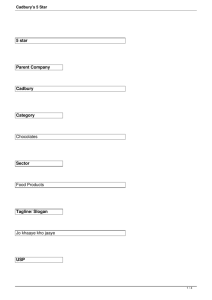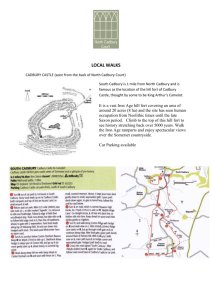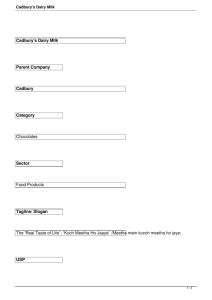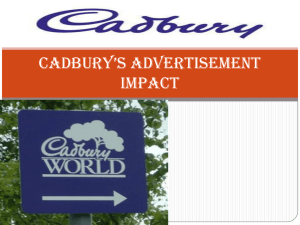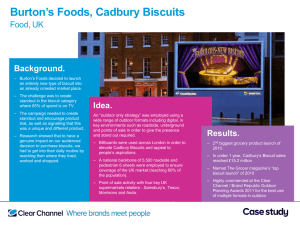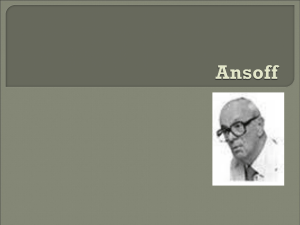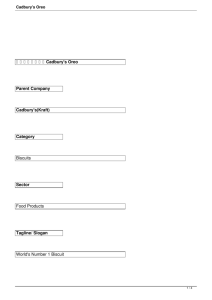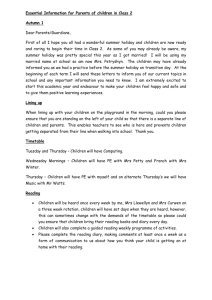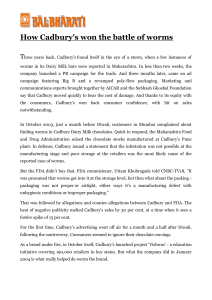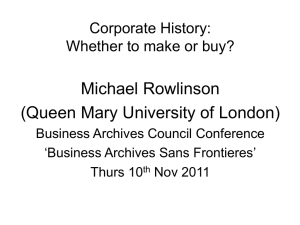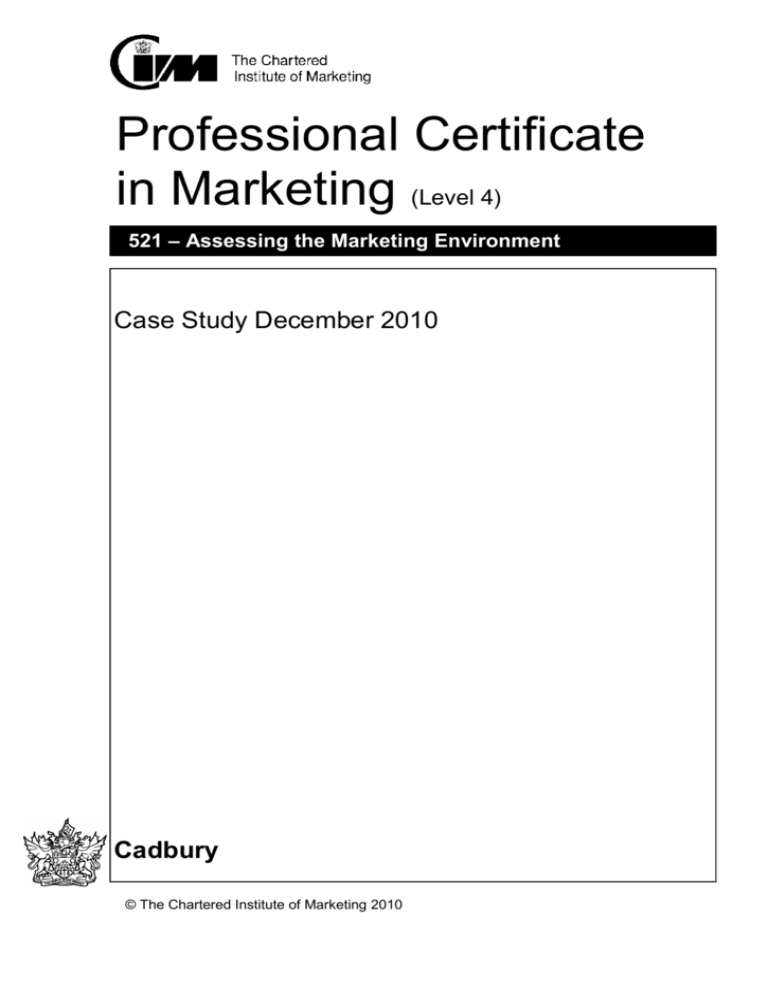
Professional Certificate
in Marketing (Level 4)
521 – Assessing the Marketing Environment
Case Study December 2010
Cadbury
© The Chartered Institute of Marketing 2010
Assessing the Marketing Environment Case Study December 2010
Assessing the Marketing Environment – Case Study
Important guidance notes for candidates regarding the pre-prepared analysis
The examination is designed to assess knowledge and understanding of the Assessing the
Marketing Environment syllabus in the context of the relevant case study. The examiners will
be marking candidates’ scripts on the basis of the questions set. Candidates are advised to
pay particular attention to the mark allocation on the examination paper and plan their time
accordingly.
Candidates should acquaint themselves thoroughly with the case study and be prepared to
follow closely the instructions given to them on the examination day. Candidates are advised
not to waste valuable time collecting unnecessary data. The cases are based upon real-life
situations and all the information about the chosen organisation is contained within the case
study. No useful purpose will therefore be served by contacting companies in the industry
and candidates are strictly instructed not to do so as it may cause unnecessary confusion.
As in real life, anomalies may be found in the information provided within this case study.
Please state any assumptions, where necessary, when answering questions. The Chartered
Institute of Marketing is not in a position to answer queries on case data. Candidates are
tested on their overall understanding of the case and its key issues, not on minor details.
As part of the preparation for the examination, candidates will need to carry out a detailed
analysis of the case material ahead of the examination. Candidates will find that the time
available during the examination is sufficient to answer the compulsory questions, but only if
detailed analysis has been undertaken beforehand. When compiling their analysis,
candidates should only use the information found within the case, supported by their
knowledge and understanding of the syllabus.
The copying of pre-prepared ‘group’ answers, including those written by
consultants/tutors, or by any third party, is strictly forbidden and will be penalised by failure.
The questions will demand analysis in the examination itself and individually composed
answers are required in order to pass.
Candidates will then need to condense their analysis into both a PESTEL and SWOT
analysis (a maximum of FOUR sides of A4, no smaller than font size 11. No other models
should be included in this analysis. The content of tables, models or diagrams must be in a
minimum of font size 8). The analyses should be numbered for ease of reference when
answering the examination questions.
Candidates must hole-punch and staple their analysis in the top left hand corner. They
should have written their CIM membership number and examination centre name on the top
of the right hand corner of each page of the analysis. It should then be attached to the
answer book on completion of their examination, using a treasury tag provided.
Although no marks are awarded for the analysis itself, candidates will be awarded marks for
how the analysis is used to answer the questions set. Candidates are advised not to repeat
or copy the analysis summary when answering the exam questions. It is important that
candidates refer the examiner to the analysis summary, where and when appropriate, when
answering the questions.
Page 2
Professional Certificate in Marketing
Candidates are only permitted to take their analysis into the examination room. Candidates
are not permitted to take in the downloaded case study or any other notes. The invigilator
will issue candidates with a new clean copy of the case study at the start of the examination
along with the question paper.
Candidates may not attach any other additional information in any format to their answer
book. Any attempt to introduce such additional material will result in the candidate’s paper
being declared null and void.
The Chartered Institute of Marketing reserves the right not to mark any submission
that does not comply with these guidelines.
Important Notice
The following data has been based on real-life organisations, but details have been changed
for assessment purposes and do not necessarily reflect current management practices of the
industries or the views and opinions of The Chartered Institute of Marketing.
Candidates are strictly instructed NOT to contact individuals or organisations mentioned in
the case study or any other organisations in the industry. Copies of the case study can be
downloaded from the CIM student website www.cimlearningzone.co.uk
© The Chartered Institute of Marketing 2011. All rights reserved. This assessment, in full or
in part, cannot be reproduced, stored in a retrieval system or transmitted in any form or by
any means, electronic, mechanical, photocopying, recording or otherwise, without prior
written permission of The Chartered Institute of Marketing.
Page 3
Assessing the Marketing Environment Case Study December 2010
ASSESSING THE MARKETING ENVIRONMENT
CASE STUDY
Preparation
In preparation for the examination you will need to analyse the Cadbury’s case material
provided, in order to prepare both PESTEL and SWOT analyses of the company. You will be
given a clean copy of the case study on the day of the examination, but you must bring the
PESTEL and SWOT analyses with you into the examination. Your written analyses must not
exceed FOUR A4 sides and must be submitted with your answer book as appendices on
completion of the examination.
Page 4
Professional Certificate in Marketing
Case Study: Cadbury
Introduction
Cadbury is an historic British confectionery company, with operations in 60 countries, and in
2008 was the second largest confectionery company in the world, behind Mars, the US
family firm, but ahead of Nestlé, the Swiss conglomerate and world’s largest food company.
Despite increased competition from small, niche producers, and the promotion of healthier
eating by Western governments, Cadbury has continued to thrive in recent years.
With a number of iconic brands that are part of the fabric of daily life in the UK, and many
memorable and innovative advertising campaigns, Cadbury is a well-loved company, close
to the hearts of many British consumers.
In November 2009, the US company Kraft, originally a processed cheese manufacturer,
launched a hostile takeover bid for Cadbury. On 2 February 2010, Cadbury’s shareholders
accepted an improved bid of 850p per share, and Kraft took ownership of the company. With
different strengths, some analysts saw the acquisition by Kraft as a perfect fit, whilst others
doubted that two very different corporate cultures would be able to integrate properly and
exploit their synergies.
History
It was in 1824 that John Cadbury, aged 22, set up shop in Bull Street, Birmingham, in the
heart of one of Britain’s rapidly expanding industrial cities.
It was a time of rapid change in Britain – the industrial revolution was in full swing. Each year
thousands and thousands of rural workers sought work in the newly developed industrial
cities of Britain, and the 1840s saw train lines spread out across the country, making the
transport of people and goods around the country much quicker and cheaper than ever
before.
John Cadbury, a Quaker, initially sold tea, coffee and cocoa drinks in his shop, as an
alternative to alcohol. John made his own chocolate by grinding the cocoa beans himself
with a pestle and mortar. Chocolate was at that time an expensive luxury, drunk mainly by
the wealthy, due to high import duties of 2 shillings and 3 pence (pre-UK decimalisation) per
pound of cocoa.
As sales of his chocolate drinks were proving so lucrative, he started to manufacture
chocolate on a larger scale, renting a factory in 1831. By chance, the following year the
Government reduced the import duties on cocoa – making it much cheaper and more
affordable for people. The reduced taxes led to explosive growth in the cocoa market – more
than five-fold over the next eight years – something that as a manufacturer John was able to
take advantage of.
In 1847, import duties were reduced again, this time to just a penny a pound (pre-UK
decimalisation) and with the business growing rapidly, John rented a new factory in the
centre of Birmingham (Bridge Street). He asked his brother Benjamin to join the company,
becoming Cadbury Brothers of Birmingham. By 1854, the reputation of their high-quality
chocolate had spread across Britain, and they received their first Royal Warrant from Queen
Victoria as ‘manufacturers of cocoa and chocolate’.
However, all was not well. Competition from their much larger and more established rival J S
Fry and Sons, who had been making chocolate since 1761, was hitting profits and the
Page 5
Assessing the Marketing Environment Case Study December 2010
business began to make a loss. In 1855, John’s second wife died, and his health
deteriorated. He and his brother Benjamin dissolved the partnership in 1860. John retired the
following year, handing over the running of the company to two of his sons, George and
Richard.
The business continued to struggle, with George and Richard seriously considering
alternative careers. However, a trip to Holland to purchase an expensive new press led to a
dramatic change in fortune. They were the first British manufacturer to use van Houten’s
press, which squeezed most of the cocoa fat (known as cocoa butter) out of the cocoa
beans, enabling the brothers to create a purer product, free of the starches and other
undesirable ingredients rival chocolate manufacturers used to disguise the taste of the cocoa
fat.
In 1866, Cadbury’s Cocoa Essence was launched. Initially the product struggled, as it was
significantly more expensive than rival products and consumers remained unconvinced by
claims that the product’s quality represented better value for money.
In 1867, the Cadbury brothers decided to promote the product on its benefits, not its
features. The company also focused on the purity of its chocolate above all else. Cadbury’s
Cocoa Essence was subsequently advertised with the strap line ‘Absolutely Pure, Therefore
Best’ and featured endorsements from the Lancet and British Medical Journal, amongst
others.
Although sales over the next decade increased by a dramatic 114 per cent, their rivals were
also experiencing a boom, as rising incomes made chocolate affordable to more and more
people. Fry, the market leader, experienced an 85 per cent rise in sales over the 1870s,
despite sticking with their ‘adulterated’ chocolate. With sales booming, they saw no reason to
switch to Cadbury’s more expensive process.
However, the 1872 and 1875 Adulteration Acts, which forced manufacturers to state all the
ingredients used in their products, changed the market sharply in Cadbury’s favour. George
Cadbury had campaigned hard on the issue, and the passing of the laws and George’s
prominent role in the campaign gained Cadbury significant publicity – in sharp contrast, their
competitors felt compelled to justify their use of ‘wholesome’ other ingredients in their
products.
This drive for purity soon led the Cadbury brothers to drop their other ‘adulterated’ products
(which, like their rivals, used a mix of ingredients), even though they were perfectly legal and
continued to sell well. By doing so, they sent a clear message that they would not sell
anything less than pure, even though it cost them financially. As a result, they stood out
clearly from their competitors and enhanced their brand reputation enormously.
With business booming, the Cadbury brothers needed to expand production, so in 1879 they
built a new factory and houses for some of the workers, four miles south of the centre of
Birmingham. As Quakers, the brothers took seriously the welfare of their workers, and their
‘factory in a garden’, Bournville, built on green fields, was a massive improvement on the
overcrowded and insanitary city slums that the vast majority of industrial workers of the day
endured. Cadbury’s loyal workers were well paid, given affordable housing with yards,
gardens and fresh country air, and were provided with lots of green space and recreation
facilities, a medical service and pensions – a far cry from the working conditions of most
factory workers at the time.
The 1880s saw a strong response from both Fry and Rowntree to Cadbury’s Cocoa
Essence, as they brought out their own ‘pure’ products – Fry even obtained similar medical
endorsements and royal warrants. However, they were to all intents and purposes ‘me too’
Page 6
Professional Certificate in Marketing
products, and in truth no match for Cadbury’s well established Cocoa Essence, sales of
which trebled in the 1880s and doubled again in the 1890s.
In 1899, Richard Cadbury died and the firm became a limited company – Cadbury Brothers
Limited. George took on the role of Chairman, with both his and Richard’s sons becoming
directors of the company.
In 1900, Cadbury employed Cecil Aldin, a local artist, to promote its products with posters
and advertisements that have become icons of the Edwardian era. However, despite the
iconic advertising and the ongoing success of Cadbury’s Cocoa Essence, Cadbury was to
face a serious new challenge – this time from European chocolate manufacturers.
The rapid growth in the chocolate market – as it became more and more affordable for the
masses – covered over the fact that Cadbury’s long-established product was beginning to
lose market share.
The Dutch chocolate manufacturer Coenraad van Houten had invented a process that not
only reduced the bitter taste of chocolate, but made it milder and more soluble. Faced with a
superior and increasingly popular product (van Houten’s Cocoa had around 50 per cent of
the market), Cadbury stuck to its tried and tested message of purity – a message that no
longer resonated with the public, given the improvements in purity made by their rivals over
the last couple of decades, and more importantly, the shift in public perception away from
the purest chocolate being the best, to the best tasting chocolate being the best.
Cadbury eventually realised that if it was to prosper it had to move away from the approach
that had brought it such success since 1866 and the launch of Cadbury’s Cocoa Essence.
The board accepted that the pursuit of purity above all else was no longer relevant in the
marketplace, and asked George Cadbury Junior to begin developing a new alkalised cocoa
that would improve on van Houten’s.
In 1905, Cadbury launched what was to become its most famous brand, Cadbury’s Dairy
Milk. Originally sold as blocks that could be broken up into penny bars, Cadbury’s Dairy Milk
fast became the company’s best seller, slowly making headway against Nestlé, whose milk
chocolate dominated the market.
In launching a new cocoa product, Cadbury realised that it might well destroy sales of its
own flagship product, Cadbury’s Cocoa Essence, a product that had formed the bedrock of
its sales for over forty years. However, the company decided to take the risk and went ahead
with the launch of George’s new, sweeter cocoa, Bournville Cocoa, in 1906.
By 1911, sales of Bournville Cocoa outstripped those of Cadbury’s Cocoa Essence, whose
problems continued, with just half the sales seen in 1904.
By 1920, with van Houten’s Cocoa sales decimated by the First World War (1914-1918),
Bournville Cocoa had established an unassailable leadership position in the cocoa market,
with twice the volume of sales that Cadbury’s Cocoa Essence had enjoyed even at its peak.
Furthermore, by launching a cheaper version, Welfare Cocoa, in 1910, Cadbury was able to
attract sales at both ends of the market from its main British rivals, Fry and Rowntree, whose
cocoa products never recovered from Cadbury’s onslaught.
The First World War also helped increase sales of Cadbury’s Dairy Milk substantially, as
imported Swiss chocolate struggled to get through, and Cadbury’s Dairy Milk filled the void
left behind. By the time the war ended, Cadbury’s Dairy Milk was dominating the market – by
1920, its sales were 20 times those of Rowntree’s, whilst Nestlé’s chocolate was almost non-
Page 7
Assessing the Marketing Environment Case Study December 2010
existent in Britain. From that point in time, Swiss chocolate never played anything more than
a niche role in the UK confectionery market.
In 1915, Cadbury launched a box of assorted chocolates for the mass market, Milk Tray,
using purple packaging to give the box a royal association. The first boxed chocolates
targeted at the mass market, it was an instant success.
Cadbury now had in place three outstanding products, Cadbury’s Dairy Milk, Bournville
Cocoa and Milk Tray, each of which was brand leader in its category.
By now, Fry, which had invented the world’s first chocolate bar in 1847, and which had held
a dominant position in the British chocolate market for decades, was struggling to keep its
production costs down, making its chocolate increasingly expensive compared to the rest of
the market.
Whilst Cadbury continued to expand its production capacity almost at will at its large, greenfield factory in Bournville, Fry had stayed in its central Bristol home, adding capacity where it
could, with lots of small factories in various locations. As demand for chocolate grew and
grew, it was Cadbury that was best prepared and best able to meet it, more efficiently,
effectively and cheaply than its rivals.
In 1919, Cadbury merged with its weakened rival Fry.
With its strong Quaker values, Cadbury had always been a good employer. Its employees
were well paid, well trained, and often well educated in comparison with its rivals’ workers.
As a result, Cadbury was able to recruit the best and was better able to make use of its
employees’ abilities, creativity and motivation to work hard for the company. Suggested
improvements to processes or new ideas for product innovation were encouraged and acted
upon – giving Cadbury a tremendous advantage over its competitors.
One such suggestion resulted in the launch of another of Cadbury’s iconic brands in 1920 –
Cadbury’s Flake. An employee on the production line noticed that the excess chocolate on
the mould dripped, forming folds of chocolate that would dry hard, and put the idea forward.
The 1920s and 30s saw chocolate become increasingly mass market, and with rising
volumes and lower transport costs, Cadbury was able to reduce costs – further feeding the
demand for its products. The cost of Cadbury’s Dairy Milk dropped by a remarkable 70 per
cent between 1920 and 1934 – resulting in a five-fold increase in sales. Cadbury’s
advertising constantly reinforced its key message of high-quality chocolate at affordable
prices.
By 1928, Cadbury’s Dairy Milk was the biggest selling chocolate product in Britain, yet
Cadbury had so far invested very little in advertising it. Cadbury now decided to put
substantial resources behind its leading brand, settling once and for all on a core message
of high milk content, summed up in its ‘glass and a half’ slogan – one that it still uses today.
Cadbury’s Roses brand of individually wrapped chocolates was introduced in 1938, with its
unusual box shape designed to imitate a popular style of handbag at the time, the ‘Dorothy’.
The name aimed to draw on the association of Cadbury with its ‘factory in a garden’,
Bournville, where roses grew. The product made a strong entry into the relatively new ‘twist
wrap’ chocolate market.
That same year, a remarkable 150,000 visitors toured the Bournville factory and village, with
George Cadbury Junior (the grandson of the founder) even known to hand out sweets to
visitors on occasion. Visitor tours had begun as early as 1902, and after the First World War,
Page 8
Professional Certificate in Marketing
railway excursions to the factory and village proved popular – all part of Cadbury’s efforts to
engage the public.
In September 1955, Britain’s first commercial TV station, ITV, was launched, and Cadbury’s
Drinking Chocolate was one of just 24 adverts to appear on the opening night.
The 1950s, 60s and 70s saw Cadbury use mass advertising to help strengthen its popular
brands and maintain its dominant position in the chocolate market. This helped Cadbury to
keep its brands at the forefront of consumers’ minds, reach the mass audiences that are so
essential to it at a relatively low cost, and prevent all but its most resource-rich competitors
from bringing their products to a national audience for any sustained period.
In 1969, Cadbury merged with Schweppes, becoming Cadbury-Schweppes – a name that
would last for 39 years. Cadbury’s new Chairman, Adrian Cadbury, was approached by
Schweppes about the merger, which he agreed to as he felt it would help Cadbury gain
sales internationally and focus more on achieving profits.
The 1970s saw strong sales growth on the back of a string of successful TV advertising
campaigns, in particular for Dairy Milk, Flake, Fudge and Milk Tray, amongst others. Sales of
Cadbury’s Dairy Milk Fruit and Nut rose 73 per cent between 1970 and 1974 on the back of
a series of TV campaigns. With only one commercial TV station (until 1982 when Channel 4
was launched) and without the distraction of computer games and other gadgets, Cadbury’s
TV adverts proved highly effective in reaching mass TV audiences.
One of Cadbury’s most popular products today, Cadbury’s Creme Eggs, was launched in
1971, although its famous ‘How do you eat yours?’ campaigns did not begin until 1985.
Despite its success, by the end of the 1970s Cadbury was beginning to lose focus and its
production facilities, once its pride and joy, were gradually falling behind those of its
competitors.
In 1980, Dominic Cadbury took over as Cadbury Chairman with a clear vision of what
needed to be done if Cadbury was to remain competitive in an increasingly global market.
He transformed production, installing state-of-the-art machines, and slashed the number of
product lines from 78 to 33, to help Cadbury focus its energies on key products and markets.
Surprisingly for a company with such iconic brands, the use of the famous Cadbury
signature, first introduced in 1921 on its transport vehicles, was inconsistent, appearing in
different sizes, colours, and on some products but not others. Starting in 1985, the Cadbury
signature began to be used consistently as a corporate logo, and it was agreed that it would
only be used on Cadbury’s chocolate and cocoa products – a process that would take until
2003 to complete.
In 1990, a new visitor centre at Bournville was opened, Cadbury World, at a cost of
£6 million (US$9 million). It attracted an impressive 350,000 visitors in its first year.
With TV audiences fragmenting and ever more cynical viewers, Cadbury began sponsoring
Coronation Street, one of the most popular TV shows in the UK, in 1996. With 10 million
viewers per episode, the long-term sponsorship of the programme (where Cadbury was
featured at the start and end of every ad break), helped Cadbury consistently connect with a
mass audience and raise awareness of its new products. After ten successful years,
Cadbury ended the £10 million (US$15 million) a year contract in 2007.
Page 9
Assessing the Marketing Environment Case Study December 2010
In 1999, Miniature Heroes were launched (soon renamed Cadbury Heroes). These were
packaged for sharing, in a tub containing individually wrapped miniature versions of some of
Cadbury’s favourite chocolates. They instantly proved popular.
Cadbury achieved its long-held aim of becoming the world’s largest confectionery company
in 2003 when it purchased Adams, the US chewing gum giant and maker of the Trident and
Stride brands.
In 2005, Cadbury bought the organic chocolate company Green & Black’s. Its owners, Craig
Sams and his wife Jo Fairley, had successfully managed in just over a decade to carve out a
niche for it in this highly competitive market as a strong brand with high ethical values.
Cadbury agreed to allow Green & Black’s management team to continue running the
business as a stand-alone company.
TV viewers in the UK, in 2007, were treated to one of the great adverts of recent years,
courtesy of Cadbury. Its groundbreaking ad featured a gorilla at a drum kit, preparing to play
the drums, before dramatically launching into Phil Collins’ song ‘In the air tonight’.
The ad was first launched on the internet and had already gone viral amongst internet users
before being broadcast on TV. The official clip has now had over 4 million views and the ad
won numerous ad industry awards. More importantly for Cadbury, the ad delivered an
impressive 9 per cent growth in sales of Cadbury’s Dairy Milk over the previous year.
In 2009, Cadbury had another hit on its hands with its ‘eyebrows’ advert, again subtly
branded, and featuring two children whose eyebrows dance in a rather remarkable way.
After 39 years together, Cadbury and Schweppes demerged in 2008, so each could
concentrate on its core business. The move meant Cadbury was no longer distracted by its
US drinks business and could instead focus more clearly on the chocolate and confectionery
markets.
Confectionery Market Categories
The confectionery market consists of two categories – chocolate and sugar confectionery.
Chocolate confectionery is sub-divided into the following categories:
Countlines (individual chocolate bars such as Mars’ Snickers and sharing bags such
as Nestlé’s Smarties)
Boxed chocolates (such as Cadbury’s Milk Tray and Cadbury’s Heroes)
Blocks and moulded chocolate (such as Cadbury’s Dairy Milk or Mars’ Galaxy)
Other, including seasonal (such as Cadbury’s Creme Eggs)
Sugar confectionery is sub-divided into the following categories:
Fruit sweets – includes chews, gums and jellies (such as Nestlé Rowntree’s Fruit
Pastilles and Mars’ Starburst)
Chewing and bubble gum
Mints
Other – includes traditional sweets, toffees.
Page 10
Professional Certificate in Marketing
Global Confectionery Market
The global confectionery market was estimated to be worth around US$128 billion in 2008,
with Europe accounting for 49 per cent of the market’s value.
Based on figures from 2006, confectionery consumption is heaviest in Northern Europe, with
the Norwegians eating the most confectionery per person a year at 15.69kg, followed by the
Danes at 15.52kg, Britons at 15.23kg and the Germans at 15.11kg a year.
In contrast, Americans eat just 11.6kg a year, the Spanish 4.98kg, the Japanese 3.59kg,
Brazilians 2.94kg, and the Chinese just 0.63kg a year.
Looking specifically at the chocolate confectionery market, the Swiss actually consume the
most chocolate per person a year at 10.05kg, closely followed by the British at 9.97kg per
person a year. Again, this is in sharp contrast with emerging markets such as Brazil or
China, where the figures are 1.11kg and 0.12kg respectively.
It is hardly surprising that Western countries have a wide range of choice and goods that are
heavily branded and packaged. Here, leading brands have invested heavily in the chocolate
market in recent years, particularly in developing limited editions and introducing brand
extensions.
In other markets, due to lower demand and lower expenditure, confectionery choice is more
limited, and is often met by local producers. However, all the main confectionery companies
are targeting growth in new markets, particularly Eastern Europe. In addition, Cadbury is
also targeting growth in India and Latin America, where traditionally confectionery
consumption has been low.
In the sugar confectionery market, Wrigley and Cadbury’s Trident have been competing for
market share. More generally, the market has seen a move away from preservatives and
artificial colours and towards using ingredients such as fruit juice instead – a move towards
more ‘natural’ products.
Industry Players
Although the global confectionery market is heavily fragmented, with lots of small, national or
local companies that cater for particular local preferences and tastes, three companies
account for a third of the global confectionery market.
In 2008, Mars became the largest confectionery company in the world having acquired
Wrigley, the leader in the chewing and bubble gum subsector. Mars had a 14.5 per cent
market share in 2008, followed by Cadbury with 10.2 per cent, and then Nestlé with a 7.7 per
cent share of the global confectionery market. Other significant players include Kraft with 4.7
per cent and Hershey’s with a 4.6 per cent share.
Page 11
Assessing the Marketing Environment Case Study December 2010
Mars Profile
Founded by Frank C. Mars in 1911 in Tacoma, Washington, USA, the Mars company
continues to be entirely owned by the Mars family.
It is the world’s third largest food manufacturer, and following its purchase of Wrigley’s (the
world’s largest chewing gum manufacturer) for US$23 billion in 2008, it became the world’s
leading confectionery company.
In 2009, it achieved sales of US$28 billion, helped by billion-dollar brands such as M&Ms,
Snickers, Dove, Mars, Extra and Orbit.
It sells seven of the top twenty best-selling chocolate snacks, including the world’s bestselling chocolate bar, Snickers, with annual global sales of US$2 billion.
Mars employs more than 65,000 people worldwide, in 230 locations and 68 countries.
One of the company’s most famous chocolate bars, the Mars bar, was developed, produced
and first sold in the UK by Frank’s son, Forrest E. Mars, from the company’s factory in
Slough, Berkshire, in 1932.
Nestlé Profile
Founded by Henri Nestlé, a pharmacist, in 1866, when he invented formula milk for infants,
Nestlé now claims to be the world’s leading nutrition, health and wellness company.
Nestlé is the world’s biggest food company, with sales of 109.9 billion CHF (US$102 billion)
in 2008, generating a profit of 18 billion CHF (US$16.8 billion). Its headquarters are in
Vevey, Switzerland, and it employs 283,000 people around the world.
Confectionery accounted for 11 per cent of Nestlé’s sales in 2008, with sales of 12.4 billion
CHF (US$11.5 billion) in its chocolate, confectionery and biscuits group, and earnings before
interest and tax of 1.6 billion CHF (US$1.5 billion).
Nestlé’s confectionery products include Aero, After Eight, Black Magic, Dairy Box, Fruit
Pastilles, Kit Kat, Milkybar, Polo, Quality Street, Smarties, Toffee Crisp, and the Yorkie bar.
In the UK and Ireland, Nestlé employs nearly 7,000 people at 23 locations. It is estimated
that 95 per cent of the UK population eat or drink Nestlé products.
UK Confectionery Market
The UK confectionery market is a mature market with high penetration levels across all
sections of society.
There are 275 confectionery manufacturers in the UK, though almost all of these are small to
medium-sized enterprises. These manufacturers mainly produce sugar confectionery, such
as boiled and traditional sweets, which are sold loose. Most companies lack the resources to
finance the launch of their brands on a national scale, which would help them increase sales
and develop their business further.
Well-established and powerful global players such as Mars, Cadbury and Nestlé, amongst
others, with their strong brands, combined with the high cost of national campaigns, act as a
significant barrier to entry for all but a few manufacturers.
Page 12
Professional Certificate in Marketing
Even for the established industry players, product innovation is expensive (in terms of
establishing a new product brand across the country) and therefore risky in such a
competitive market. As a result, product innovation is rather limited, with key industry players
preferring to extend existing well-known brands with new flavours rather than try any radical
new ideas.
Sales of confectionery in the UK are estimated to have grown 6.9 per cent between 2004
and 2008, with very little growth up until 2007, when the value of the confectionery market
rose sharply due to price rises (reflecting the higher cost of ingredients and transport costs)
and the growth of premium products such as Green & Black’s organic chocolate, which
commanded a higher price.
Since the recession began in April 2008, the value of the UK confectionery market has
dropped slightly (falling to £4.6 billion or US $7 billion in 2008), but is faring much better than
many other sectors of the economy.
Although the UK economy has contracted by a massive 6.25 per cent since April 2008, with
six successive quarters of negative growth in GDP – the deepest and longest recession
since the Second World War – confectionery is generally seen as recession-proof. In tough
times, people still want to enjoy their little treats or ‘comfort’ food.
Within the chocolate confectionery sector, countline (individual chocolate bars and
multipacks) remains the most popular category, accounting for 43 per cent of the sector in
terms of value (2008 figures), followed by boxed chocolates and sharing bags with 27 per
cent, blocks and moulded chocolates with 22 per cent, and other chocolate confectionery
with 8 per cent of the chocolate confectionery sector.
Chocolate bars are widely available in supermarkets, snack bars, petrol stations and vending
machines, and has market-leading brands in Cadbury’s Dairy Milk, Nestlé’s Kit Kat, and the
Mars bar amongst a range of Mars products in this category.
The boxed chocolates category is dominated by ‘occasions’ and the giving of gifts (for
birthdays, Christmas, Valentine’s Day etc). Whilst products such as Cadbury’s Milk Tray,
Thornton’s Continentals (a UK specific chocolate confectionery company) and producers at
the premium end of the market such as Hotel Chocolat continue to dominate more formal
occasions, there has been significant growth in the giving of more informal gifts in the shape
of sharing bags, such as Cadbury’s Roses, Cadbury’s Heroes and Mars’ Celebrations.
Within the block and moulded bar chocolate category, it is the premium brands that have
been hit hardest, as consumers rein in their spending and trade down to more mass market
brands such as Cadbury’s Dairy Milk and Mars’ Galaxy, which have seen a rise in sales
values. Price rather than high-quality ingredients appears to be driving sales in this category
once again.
UK Market Trends
One of the most significant trends affecting the confectionery market is the focus by
government and public health bodies on reducing obesity, particularly amongst children, and
to encourage everyone to eat more healthily. With products that are high in fat and sugar,
the confectionery industry is under pressure to reduce these in its products and play its part
in getting people to eat sensibly and healthily.
Although the UK government has put considerable sums of money into promoting healthier
lifestyles to the UK public, consumer research for Keynote has revealed that confectionery is
still largely viewed as a ‘low-cost, harmless indulgence’. In fact, the percentage of
Page 13
Assessing the Marketing Environment Case Study December 2010
respondents saying that they were worried about the issue actually fell between 2006 and
2008. It seems that in general the government’s health messages are making little headway
in consumers’ minds.
Confectionery companies have responded by producing smaller or lower fat varieties of their
famous brands, most notably Nestlé’s low-fat Kit Kat Senses, launched in 2008 and aimed at
women.
Another major trend in the UK confectionery market is that of Britons increasingly seeking
their entertainment indoors, dubbed the ‘big night in’. With home cinemas, high-definition
digital TV, games consoles, and a ban on smoking in pubs and clubs, more and more people
are choosing to stay at home to spend time with and entertain friends and family. The
recession has also led many people to cut back on dining out, further fuelling the trend of
staying at home.
As a result, chocolate boxes for sharing, such as Cadbury’s Heroes and Mars’ Celebrations,
and the more informal sharing bags, have experienced strong growth at the expense of the
more formal boxes of chocolates such as Cadbury’s Milk Tray.
One of the more surprising trends over the last decade or so has been the rise in popularity
of dark chocolate. With its more bitter taste, it has long been a niche product with limited
appeal. However, the last few years have witnessed renewed interest in dark chocolate and
its healthy benefits (due to its high level of antioxidants).
A number of premium brands, such as Green & Black’s and Montezuma’s, have emerged,
proclaiming the high cocoa content of their chocolate and adding unusual flavours to them,
such as spices. Not only has demand for these premium products grown strongly, it has led
to mainstream brands producing ‘dark’ versions of some of their own products, such as Dark
Chocolate Twix and Kit Kat Dark. With strong demand and higher prices, these new,
premium chocolate brands have been able to secure wide distribution, either through
retailers’ own label products, on supermarket shelves, or through independent specialists.
Intriguingly, the quality of premium chocolate is once again coming to be judged in no small
part by the level of cocoa used in its production.
Another major trend in recent years has been a marked rise in interest, among a significant
proportion of UK consumers, in seeing that goods are produced in an ethical and sustainable
manner.
The first product in the UK to carry the Fairtrade logo was Green & Black’s Maya Gold in
1994 (the Fairtrade Foundation ensures that farmers are paid a fair price for their produce,
often above the market price).
With its distinctive, organic dark chocolate and strong ethical values, Green & Black’s quickly
carved a niche for itself. Its phenomenal success led to other ethical chocolate brands such
as Divine entering the market. In 2004, the company achieved sales growth of 69 per cent
and a turnover of £22 million (US$33 million). Such striking success attracted the interest of
the major confectionery companies, and in 2005, the company was sold to Cadbury, which
allowed the management team to continue running the business as a stand-alone company.
In March 2009, Cadbury announced that its best-selling brand, Cadbury Dairy Milk, would be
made using Fairtrade cocoa, meaning that cocoa farmers in the developing world will be
paid fairly for their produce, often at above market rates. The first Fairtrade bars rolled off the
production line in July 2009. Nestlé, one of Cadbury’s main rivals quickly followed suit and
Page 14
Professional Certificate in Marketing
launched a global Cocoa Plan to help cocoa farmers in the developing world. Its leading
confectionery brand, Kit Kat, also became a Fairtrade product in January 2010.
How much the recession and its aftermath will affect the ethical confectionery market with its
premium-priced products remains to be seen, though the brands concerned may well have
built up substantial brand loyalty to insulate them from its worst effects.
Concern about the environment is also having an impact on the packaging of products, with
the industry coming under fire for its excessive and unnecessary packaging, particularly with
regard to chocolate Easter eggs.
In response, Nestlé has removed plastic packaging from 80 per cent of its Easter eggs, and
reduced its packaging by 30 per cent altogether, whilst Mars has reduced the weight of its
plastic inserts by 35 per cent, resulting in 69 tonnes of less plastic being used.
In common with other markets, nostalgia is an important trend that confectionery companies
are tapping into. In 2008, Cadbury permanently brought back the Wispa bar in the UK after a
campaign on the social networking site Facebook to get Cadbury to make it again (it had
been dropped in 2003 due to poor sales). Wispa sold 20 million bars in just seven weeks,
making it one of the most successful confectionery product launches of all time.
Besides Cadbury’s reintroduction of the Wispa bar, 2008 also saw Mars resurrect its Opal
Fruits (fruit chews) and Nestlé the Drifter (chocolate bar).
A new trend that is emerging is the development of ‘functional foods’. In September 2008,
Guylian, the Belgian chocolate company, launched its Extra Shells, made using dark
chocolate with high levels of antioxidants. Guylian claims that eating just two of these
chocolates could deliver 60 per cent of someone’s daily requirement for antioxidants.
Another innovation that may spark similar developments is the attempt by Cadbury to extend
seasonal confectionery beyond its limited timeframe. In May 2008, in an effort to extract
further sales from its popular Cadbury’s Creme Egg (which is only available for Easter,
usually from January till April), Cadbury launched a spin-off product, the Creme Egg Twisted,
which would be available all year round, with the ambition of turning it into a year-round
phenomenon.
Cadbury’s Performance
In 2003, with the purchase of Adams, the world’s number two chewing gum manufacturer,
Cadbury achieved its aim of becoming the world’s leading confectionery company.
Since 2004, Cadbury has continued to gain global market share in the confectionery market.
Despite having a 10.2 per cent share of the global confectionery market, in 2008 it lost its
number one position to Mars when that company acquired Wrigley’s. In 2009, Cadbury
achieved global sales of £6 billion (US$9.2 billion), with underlying revenues up 5 per cent
on the year, in line with its objective of achieving 5-7 per cent organic growth each year.
Growth in Cadbury’s sales in emerging markets was however markedly higher, at an
average of 10 per cent per annum.
In India, Cadbury achieved sales growth of 20 per cent per annum, as it has done for the last
four years, helped by the launch in 2008 of a heat-resistant candy-coated sweet known as a
Dairy Milk Shot. The product is directly targeted at increasing market share in India, where
chocolate sales are low, and the average person eats the equivalent of just one Wispa bar a
year. With sales of just £200 million for the country in 2008, Cadbury is building up from a
Page 15
Assessing the Marketing Environment Case Study December 2010
low base. It now has a 70 per cent share of the chocolate market in India – its nearest rival is
Nestlé with a 25 per cent market share.
Cadbury also performed strongly in other emerging markets in 2009, with 18 per cent sales
growth in South America and 14 per cent in the Middle East.
With its strong British roots, the UK and Ireland remain core markets for Cadbury,
accounting for 25 per cent of its business. North America accounts for 22 per cent of
revenues, and Europe a further 20 per cent. The Pacific brings in 12 per cent of Cadbury’s
revenues, followed by Latin America with 8 per cent, Africa and the Middle East with 7 per
cent, and finally Asia with just 6 per cent of Cadbury’s revenues.
Within the UK market, monthly figures for 2009 reveal a relatively stable picture. Cadbury
consistently had the largest share of the chocolate market, and apart from slipping slightly
below 30 per cent in November (down 1.7 per cent to 29.8 per cent), the company achieved
a 30 per cent or higher market share throughout the rest of 2009.
Cadbury’s nearest rival in the UK is Mars which had a 27 per cent market share in 2009,
followed by Nestlé on 21 per cent and Kraft, maker of Toblerone, trailing far behind the big
three on 5 per cent of the UK chocolate market.
Cadbury has also produced an impressive 31 per cent growth in profits in the two years
since its turnaround plan, ‘Vision into Action’, was launched in 2007.
The plan has the specific goal of improving Cadbury’s operating margins. One of the ways it
is achieving these gains is by closing manufacturing plants in more expensive countries such
as Spain, Turkey and the UK, and moving production to where costs are lower, such as
Poland.
The company employs 50,000 people worldwide, including 7,000 in the UK and Ireland, and
has operations in 60 countries.
Kraft and Cadbury
From its humble origins as a processed cheese manufacturer, Kraft has become one of the
largest food companies in the world, generating US$40 billion revenues in 2009.
Particularly strong in its homeland, the USA, the last couple of decades have seen the
company attempt to strengthen its position in other key markets, such as the European
market, through the acquisition of Jacobs Suchard, and more recently the biscuit business of
Danone, amongst others.
In August 2009, the Chief Executive and Chairman of Kraft, Irene Rosenfeld, approached
Cadbury’s Chief Executive, Roger Carr, about an offer for Cadbury – an offer that was
rejected as too low.
The following month Kraft made another approach to Cadbury, valuing the firm at £10.2
billion. The offer was almost immediately rejected by Cadbury’s board, with Carr going public
about Kraft’s approach and Cadbury’s determination to continue as an independent
company. Cadbury’s CEO, Todd Stitzer, also defended Cadbury’s performance and its
future growth prospects, particularly in emerging markets.
Cadbury’s position was strengthened by strong results for the third quarter of 2009, where it
achieved a 7 per cent increase in sales. In contrast, Kraft announced it was reducing its
sales growth forecasts from 3 per cent to 2 per cent.
Page 16
Professional Certificate in Marketing
In November 2009, Kraft launched a hostile takeover bid, valuing the company at £9.8
billion. Confectionery companies Ferrero Rocher and Hershey both expressed an interest in
buying Cadbury. Although any loss of independence was unwelcome, Carr indicated that if
Cadbury were to be taken over, Hershey would be preferred, given its similar values to
Cadbury – even though it was half the size of Cadbury.
Another potentially interested party was Nestlé, the world’s biggest food company. However,
Kraft sold its frozen pizza business to Nestlé in early January 2010 for US$3.7 billion, which
took Nestlé out of the running and raised much needed cash for Kraft for the takeover bid.
On 19 January 2010, the Cadbury board finally accepted an improved offer from Kraft of
£11.9 billion (US$19.6 billion), which was agreed by over 70 per cent of shareholders on 2
February, handing control of the company to Kraft.
The takeover sparked much debate in the UK, with many media commentators, consumers,
and indeed government ministers, unhappy that a much-loved British company was taken
over by a foreign firm.
Many people in the UK have fond memories of Cadbury and its chocolates and an emotional
attachment to the company and its products – from happy childhood memories of its sweets
through to a pride in its philanthropic roots and social reform. They were therefore opposed
to the takeover and felt that an important British company and its distinctive values would be
lost.
The fact that Kraft borrowed £7 billion (US$11.5 billion) of the money it needed to buy the
firm from a British bank, RBS (which is now 84 per cent owned by the UK government after
being bailed out), angered many British people.
With London as a major financial centre, the UK has been very open to takeovers, with many
of the UK’s leading companies falling into foreign ownership over the last decade – Abbey to
Santander of Spain in 2004, P&O to Dubai Ports World in 2006, Alliance Boots to US
private-equity group KKR in 2007, and Corus (formerly British Steel) to Tata Steel of India in
2007. In many other countries, such takeovers would have been blocked if they were
deemed to be against the public interest.
Roger Carr, who has since announced that he is stepping down as Cadbury’s Chairman,
expressed his concern that Cadbury’s fate was determined not by its long-term
shareholders, but by the short-term interests of hedge funds, which built up a 30 per cent
stake in Cadbury during the takeover, and he believes, ultimately swung the outcome in
Kraft’s favour for their own financial gain. Shortly afterwards, the UK’s Takeover Panel, an
independent body that regulates takeovers in the UK, announced plans for a consultation on
whether the UK’s takeover rules need to be tightened up and whether the role of hedge
funds in hostile takeovers should be restricted.
Cadbury was also not helped in its battle against Kraft’s takeover by the substantial
devaluation of the pound since mid-2007. The Bank of England calculates the pound has
fallen in value by 25 per cent since then, making British companies much more attractive
and affordable to foreign buyers.
Some commentators have argued that Cadbury and its iconic brands were substantially
undervalued, again making it more attractive to potential bidders. According to research
carried out by Brand Finance and the Institute of Practitioners in Advertising, Cadbury’s
brands are worth around £3.2 billion (US$4.9 billion) – but were not shown on the company’s
balance sheet and were not taken into account in the calculations of Cadbury’s assets.
Page 17
Assessing the Marketing Environment Case Study December 2010
Among the most important stakeholders affected by the takeover are of course Cadbury’s
workers. Prior to the takeover, the UK’s largest trade union, Unite, which represents some of
Cadbury’s workers, warned that up to 30,000 jobs could be lost worldwide. It expressed
particular concern about Kraft’s debt of £22 billion (US$33.5 billion), and how this ‘colossal’
debt was to be serviced. The union stated that between 2004 and 2008 Kraft made 19,000
workers redundant and closed 35 sites worldwide to help reduce its debt. It raised the
prospect of Kraft moving Cadbury to its headquarters in the USA, affecting Cadbury’s 6,000
UK employees and 20,000 UK workers in its supply chain.
Whilst such fears may seem exaggerated, many of Cadbury’s workers remain deeply
concerned about what the future holds for them. Kraft has sought to reassure Cadbury’s UK
staff, with Irene Rosenfeld, Kraft’s CEO, promising to manufacture more of its global brands
in Britain – though she also said that the company’s new combined workforce of 140,000
would have to be ‘somewhat smaller’.
The UK Government also sought reassurances from Kraft that UK jobs would be protected,
a commitment Rosenfeld appeared to give to Lord Mandelson, the then Secretary of State
for Trade and Industry, when she told him that there would be no formal statements about
redundancies for six months.
However, just six days later Kraft announced the closure of a factory in Somerdale, near
Bristol, UK, with the loss of 400 jobs – despite having intimated in its bid that it would reverse
Cadbury’s earlier decision to close the plant.
Lord Mandelson stated publicly that he was unhappy with Kraft and the way the company
was conducting itself: ‘It would have been more honest, more straightforward and straight
dealing, with the company and its workforce and also the government, if she had told me
what their intentions were.’
With costs of £400 million (US$610 million) for the advisory fees for both Cadbury and Kraft
and for arranging the loans to buy Cadbury, Kraft has already paid a hefty price to make the
purchase.
However, with its takeover of Cadbury, Kraft is now the largest confectionery company in the
world, and the second largest food company (behind Nestlé). It now has global sales of
US$50 billion, 140,000 employees around the world, 11 billion-dollar brands (including
Cadbury, Milka and Trident within the confectionery market), and more than 70 US$100
million brands.
Kraft was keen to diversify away from mature Western markets. Prior to the takeover more
than half of Kraft’s sales came from the North American market, which, with official
unemployment at 10 per cent in the US, is likely to see low growth in the immediate future.
With Cadbury’s success in emerging markets such as India and Latin America, Kraft now
has a foothold in high-growth, emerging markets, helping it deliver higher growth and greater
profits in the long term.
By acquiring Cadbury, Kraft also hopes to emulate Cadbury’s ability to bring new products to
market quickly and distribute them effectively, and replicate Cadbury’s commitment to its
leading products, providing them with the research and development, manufacturing, supply
chain and commercialisation resources they need to thrive.
Kraft believes that it can achieve cost savings of £420 million (US$675 million) a year within
three years through economies of scale, streamlining procurement, and improving the
sourcing of raw materials such as cocoa, dairy and sugar.
Page 18
Professional Certificate in Marketing
Despite promises by Kraft to respect Cadbury’s proud history and heritage, it remains to be
seen whether Kraft’s purchase of Cadbury’s will deliver its hoped-for dominance of the global
confectionery market, and how well it can integrate two very different companies and
cultures.
Page 19
Assessing the Marketing Environment Case Study December 2010
APPENDIX ONE
Kraft rebuked for broken pledge on Cadbury factory
Jill Treanor 26 May 2010 Kraft rebuked for broken pledge on Cadbury factory. Available at:
http://www.guardian.co.uk/business/2010/may/26/kraft-censured-over-cadbury-takeoverpledge [Accessed March 2011]
Page 20
Professional Certificate in Marketing
Page 21
Assessing the Marketing Environment Case Study December 2010
Page 22
Professional Certificate in Marketing
Page 23
Assessing the Marketing Environment Case Study December 2010
Moor Hall
Cookham
Maidenhead
Berkshire, SL6 9QH, UK
Telephone: 01628 427120
Facsimile: 01628 427158
Website: www.cim.co.uk
Page 24

